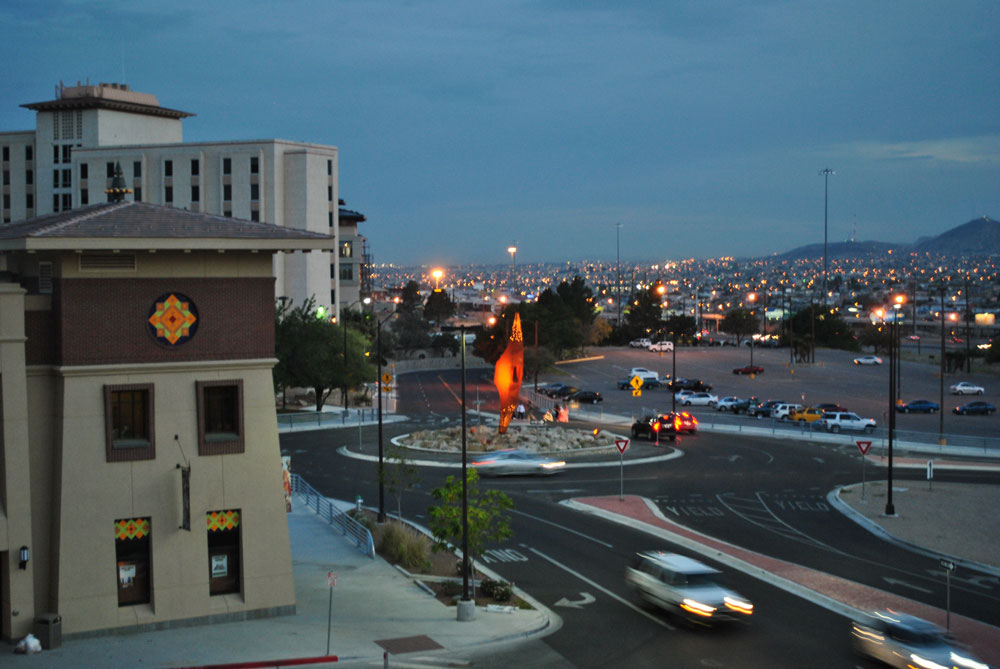
The lights of Ciudad Juarez can be seen from the UTEP campus. (Danya Hernandez/Borderzine.com)
EL PASO, Texas — A young man catches a ride with his friend and they make their half hour trip home from school across the international port of entry into the streets of the most dangerous city on the U.S.-Mexico border.
Manuel Acosta, 22, drove his red Nissan Sentra from The University of Texas at El Paso (UTEP) to the Colonia Rincones de Santa Rita where his friend Eder Diaz, 23, lived with his parents in Ciudad Juarez, Mexico. The trip home was routine to both students.
Chihuahua State Police reported that a group of masked men armed with .223 caliber rifles similar to the NATO military rifles intercepted them at the intersection of De La Arbolada and Manglares streets in near of Diaz’s house. The assailants fired 36 shots killing Acosta at the scene and fatally injuring Diaz, who died in the early morning hours of November 3 at a hospital in Juarez.
A friend of the victims commented on Facebook, “This city doesn’t stop scaring us. We keep hitting bottom. Our ex-classmates Eder Diaz and Manuel Acosta became victims yesterday of the reality that we are living. May they rest in peace.”
According to the Servicio de Aduanas y Protección de Fronteras more than 1,200 students in all grades make this trip across the border every day. Like Diaz and Acosta, they are looking for a better future, to fulfill their own dreams, and the expectations of their families and loved ones.
Ivan Herrera, a 23-year-old UTEP student who lives in Juarez said he is familiar with the dangerous trip they regularly took between UTEP and their homes. “I’m on the lookout for anything,” said Herrera.
The growing uncertainty and lawlessness in Juarez has motivated more and more students to leave their families behind and move to the U.S.
A close childhood friend of Diaz said he was still going and coming from Juarez every day up until a month ago. Sometimes he crossed the border after 10 p.m. and his father would wait for him at a specific place. “I realized I was not only putting myself in danger but my father’s as well, and when I was able to find a job here at UTEP, I made the decision to move to El Paso,” he said.
Since the fall of 2005 there has been a decrease in the number of Mexican international students enrolled in UTEP and an increase in American Hispanic students.
Currently there are more than 1,400 Mexican international students enrolled at UTEP, a great number of them still from Juarez and other parts of Chihuahua.
Many do not have the means to move to another city and have no choice but to keep commuting back and forth across the border.
In 2007 The U.S. Department of Homeland Security and Customs Agents established an express student lane to help these daily commuters reduce their wait times at the International Bridges of the Americas and Ysleta from more than one hour to 15 minutes.
The program, which charged $125 dollars for a five-year pass only lasted two years and in 2009 was replaced with the current dedicated commuter lane.
UTEP also encourages Juarez students to enroll by providing a program called Programa de Asistencia Estudiantil (PASE) that helps them pay the same tuition rate as Texas residents.
The program that was established in 1987 requires students to show proof that they are unable to pay the out-of-state tuition, proof of residence and turn in an application every year.
Since 1917 when Raul Barberena, the first international student from Juárez graduated from UTEP, Mexican students have been an important part of UTEP’s history.


Just wanted to clarify that there were at least two native Mexican students who graduated from the Texas State School of Mines and Metallurgy in 1917. Raul Ramon Barberena, of Tampico, Mexico, was joined by his classmate Henry Becker. Becker’s family was run out of Mexico during the Revolution in 1914 and they settled in El Paso. Both Henry Becker and Raul Barberena were among the first 27 students who started classes when the Texas State School of Mines and Metallurgy opened its doors on Sept. 23, 1914.
Good point, Timi. UTEP has been attracting students from Mexico since its inception. Thanks for reminding us.